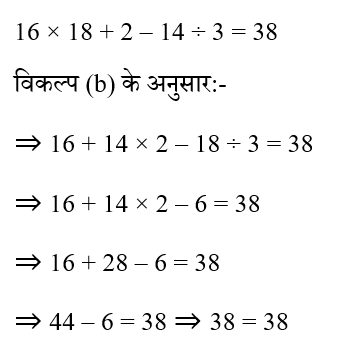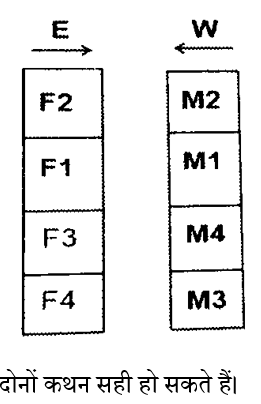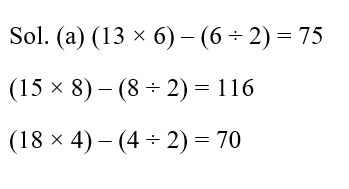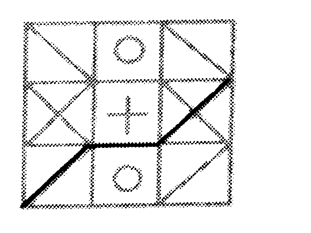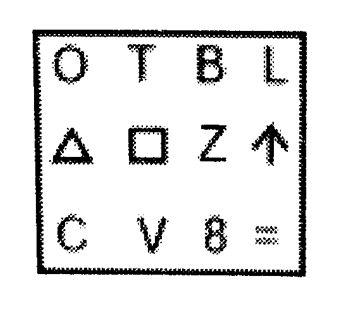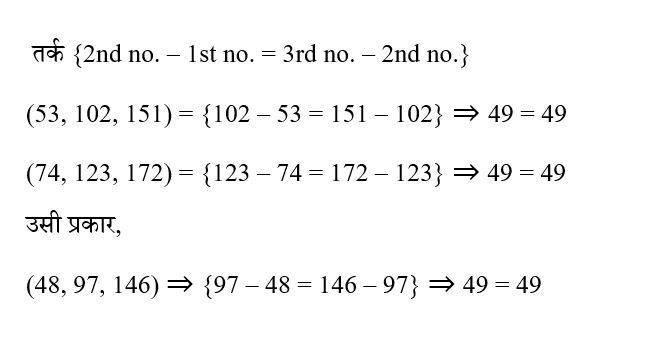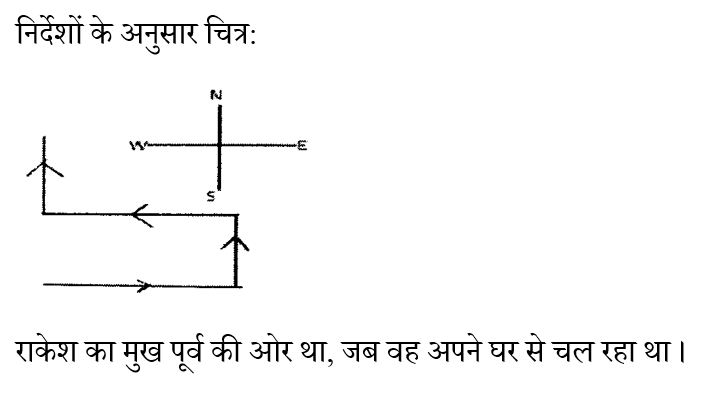Question 1:
If which two symbols or numbers are interchanged in the given expression, it will become correct?
दी गयी अभिव्यक्ति में किन दो चिन्हों या अंकों को आपस में बदलने पर वह सही होगी ?
16 × 18 + 2 – 14 ÷ 3 = 38
Question 2:
4 men M1, M2, M3 and M4 are sitting in a row facing west (not necessarily in the same order). 4 women F1, F2, F3 and F4 are sitting in a row facing these men (not necessarily in the same order). F4 is sitting on the immediate right of F3. A woman is sitting between F2 and F3. M3 is sitting diagonally opposite to F2. M2 is sitting second to the right of M4. Which of the following statements may be correct? 1. M4 is facing F3. II. M2 is sitting diagonally opposite to F4
4 पुरुष M1, M2, M3 और M4 एक पंक्ति में पश्चिम की ओर मुख करके (आवश्यक नहीं है कि इसी क्रम में हों) बैठे हैं। 4 महिलाएँ F1, F2, F3 और F4 एक पंक्ति में इन पुरुषों के मुख की ओर मुख करके (आवश्यक नहीं है कि इसी क्रम में हों) बैठी हैं। F4, F3 के सन्निकट दाईं ओर बैठी है । एक महिला F2 और F3 के बीच में बैठी है। M3, F2 के विकर्णत: सामने बैठा है। M2, M4 के दाईं ओर दूसरे स्थान पर बैठा है। निम्नलिखित में से कौन सा कथन सही हो सकता है? 1. M4, F3 की ओर मुख करके बैठा है। II. M2, F4 के विकर्णत: सामने बैठा है।
Question 3: 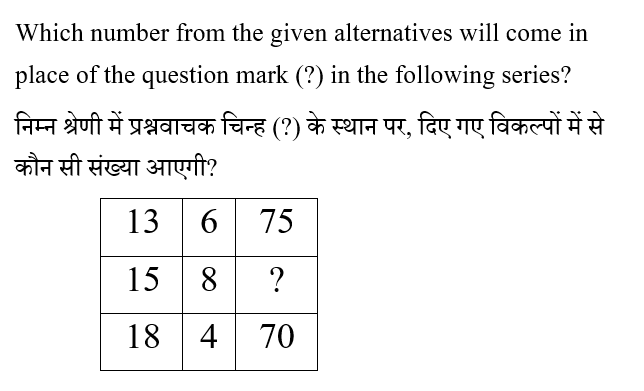
Question 4: 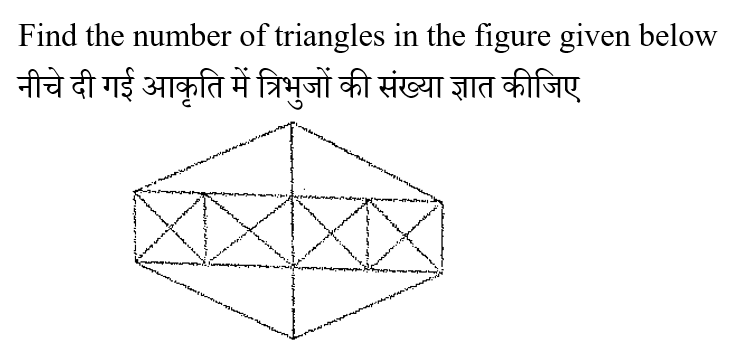
Question 5: 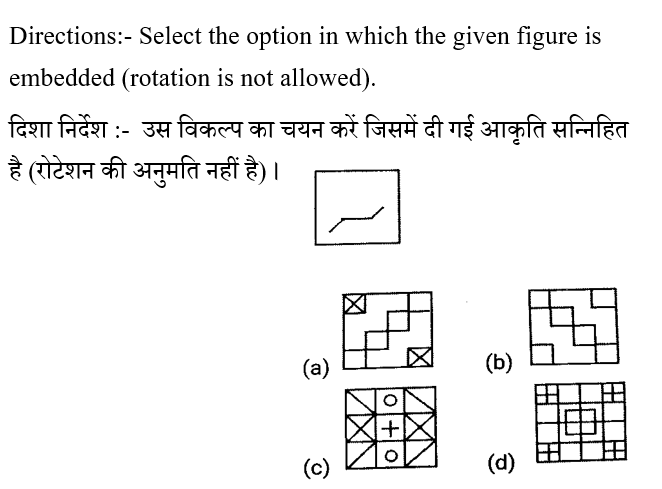
Question 6: 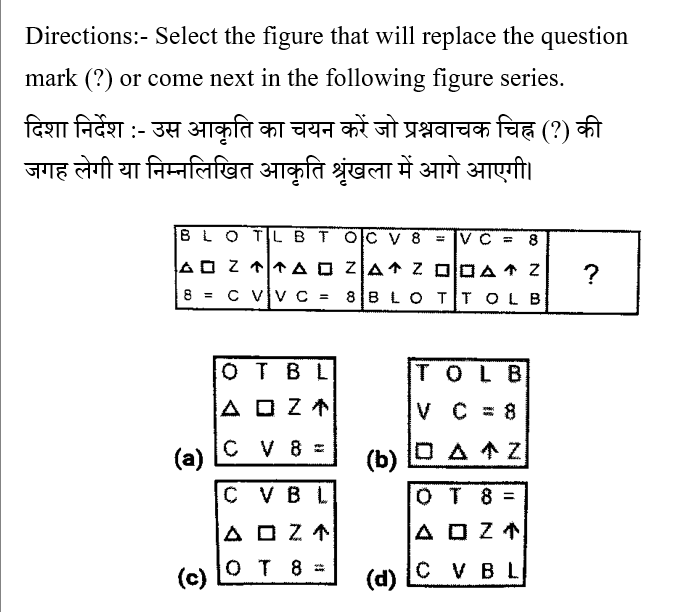
Question 7:
Select the set in which the numbers are related in the same way as the numbers in the following sets are related.
(Note: Mathematical operations should be performed on whole numbers, without dividing the number into its component digits. For example 13 if you have to perform mathematical operations on 13 like addition/subtraction/multiplication etc. then the same should be performed on 13 only. Breaking 13 into 1 and 3 and then performing mathematical operations on 1 and 3 is not allowed.
उस समुच्चय का चयन कीजिए जिसमें संख्याएँ उसी प्रकार संबंधित हैं जिस प्रकार निम्नलिखित समुच्चयों की संख्याएँ आपस में संबंधित हैं।
(नोट: संख्याओं को उसके घटक अंकों में विभाजित किए बिना, पूर्ण संख्याओं पर गणितीय संक्रियाएं की जानी चाहिए। उदाहरण के लिए 13 अगर आपको 13 पर गणितीय संक्रियाएं जैसे कि जोड़ने/घटाने / गुणा करने आदि करना है तो वह 13 पर ही की जा सकती हैं। 13 को 1 और 3 में तोड़ना और फिर 1 और 3 पर गणितीय संक्रियाएँ करने की अनुमति नहीं है|
(53, 102, 151), (74, 123, 172)
Question 8:
Select the option that arranges the following words in a logical and meaningful order.
उस विकल्प का चयन करें जो निम्नलिखित शब्दों को तार्किक और सार्थक क्रम में व्यवस्थित करता है।
1. कोषस्थ कीट / Chrysalis
2 अंडा / eggs
3. वयस्क / Adult
4. डिंभक / Larvae
Question 9:
Rakesh starts walking from his house and then turns left twice and right once to reach the market. If he is facing north when he reaches the market, then in which direction was Rakesh facing when he started walking from his house?
राकेश अपने घर से चलना शुरू करता है और फिर बाजार तक पहुँचने के लिए दो बार बाएँ मुड़ता है और एक बार दाएँ मुड़ता है। यदि वह बाजार पहुंचने पर उत्तर की ओर मुंह करके खड़ा है, जब राकेश ने अपने घर से चलना शुरू किया तो उसका मुख किस दिशा में था ?
Question 10:
Select the odd group of numbers. (Note: Operations should be performed on whole numbers, without dividing the numbers into their constituent digits. Example "13" - Operations on 13 such as adding/subtracting/multiplying etc. can be performed on 13. 13 can be converted to 1 and breaking into 3 and then performing mathematical operations on 1 and 3 is not allowed)
संख्याओं के विषम समूह का चयन करें। (ध्यान दें: संख्याओं को उनके संघटक अंकों में विभाजित किए बिना, पूर्ण संख्याओं पर संक्रियाएँ निष्पादित की जानी चाहिए। उदाहरण "13" - 13 पर संक्रियाएँ जैसे कि 13 में जोड़ना / घटाना / गुणा करना आदि किया जा सकता है। 13 को 1 और 3 में तोड़ना और फिर 1 और 3 पर गणितीय संक्रियाएँ करने की अनुमति नहीं है)

